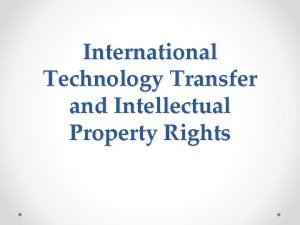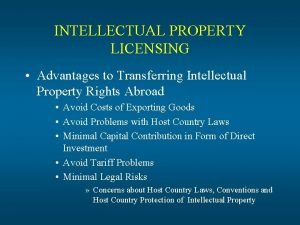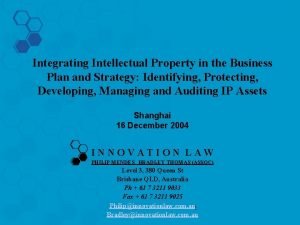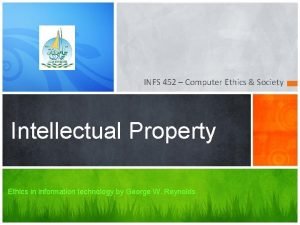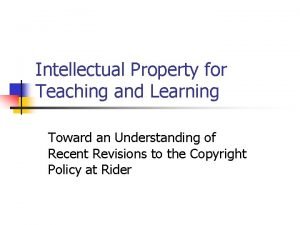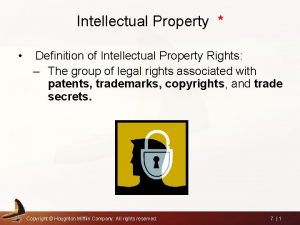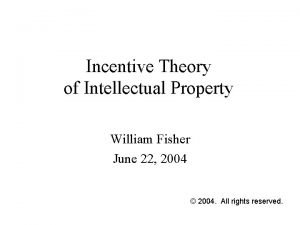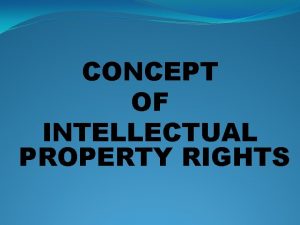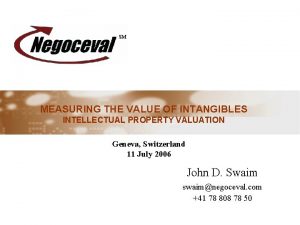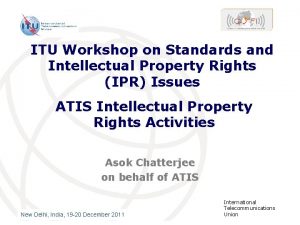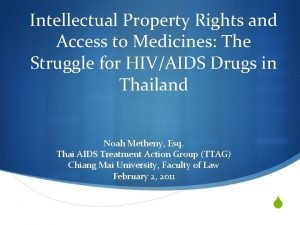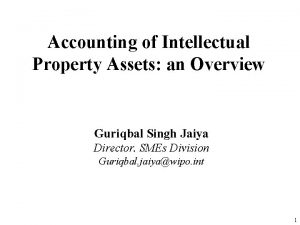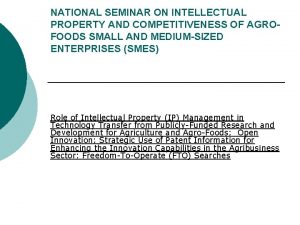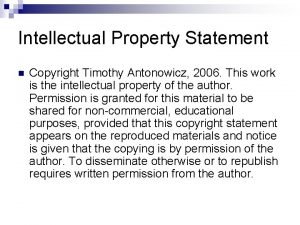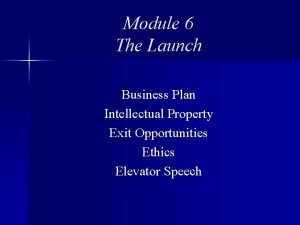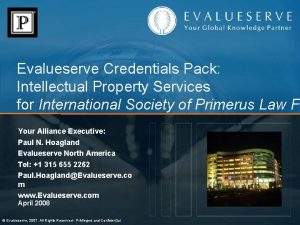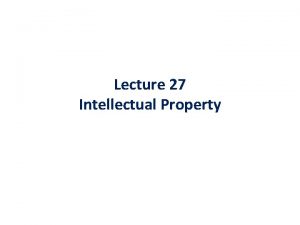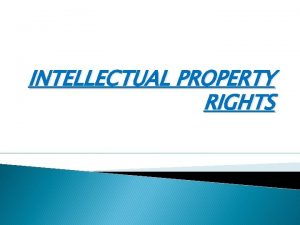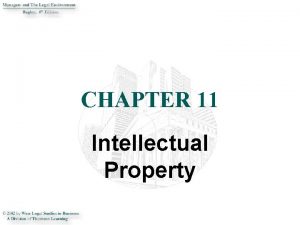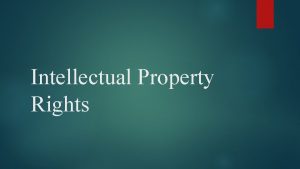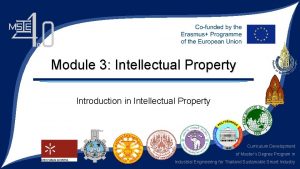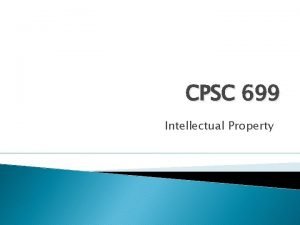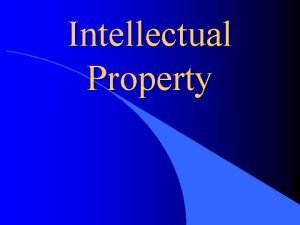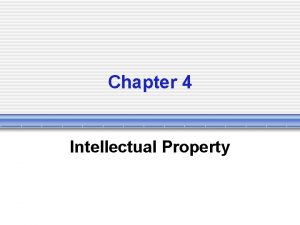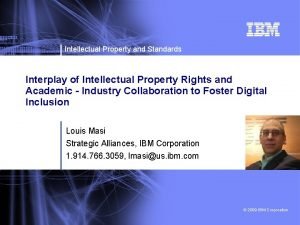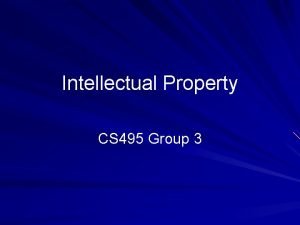Lecture 28 Intellectual PropertyContd Introduction Intellectual Property simply





















- Slides: 21

Lecture 28 Intellectual Property(Cont’d)

Introduction Intellectual Property simply defined is any form of knowledge or expression created with one's intellect. It includes such things as inventions; computer software; trademarks; literary, artistic, musical, or visual works; and even simply know-how. There are various forms of statutory protection for Intellectual Property, but the two that are most likely to be relevant in the University environment are copyright and patents.

Who Owns It? • Depends on the circumstances of the Project, nature of funding and the policies of the institution – Grant – Institution should own – Collaboration – Each should own IP it creates – Service contract – Sponsor should own • Regardless of inventor/institution policy, in the IP clause it is better to have ownership vest in Institution in the first instance • If you are giving up ownership of IP in agreement make sure you own it in the first place

I am paying for it so I should own it. . . In a collaborative research project a sponsor is never paying the full cost of the research. Overhead alone do not account for the resources that the institution is bringing to the project (including the PI’s expertise and often matching funding). In a collaborative project the parties are working together and thus should both benefit from the results.

Ownership in a Collaborative Project Company shall own all Foreground Intellectual Property conceived entirely by Company personnel (“Company IP"). University shall own all Foreground Intellectual Property conceived entirely by University personnel ("University IP"). The Parties shall jointly own any Foreground Intellectual Property conceived of by at least one individual employed by Company and at least one individual within the University (“Joint IP”). Each Party agrees to disclose promptly to the other Parties any and all Foreground Intellectual Property created by or on behalf of that Party under the Project to the other Parties regardless of whether or not capable of protection by patents, copyrights, industrial designs or design patents.

Grant of Rights • What rights of use that are given to the sponsor (or institution) again depends on the nature of the project, the type of funding and the policies of the institution • A license is the right of the party to use the IP. Can be limited by field, duration, geographical area, or exclusivity • An exclusive right means that the only person that can use the IP is the licensee – even to the exclusion of the owner

Grant of Rights • Grant of rights should be given as a time limited option. The length of time depends on the nature of the IP & industry. • Try to avoid setting royalty rates in the research agreement • Once Sponsor turns down option you should have freedom to deal with IP as you see fit.

Retained Rights • If you do not own the IP or are granting an exclusive right to use the IP to someone then you need to retain the right to use the IP for your researcher. • This would include the right to use the IP for research, teaching, publication purposes • Be aware of how giving up ownership of IP affects the rest of the agreement, particularly the publication clause and confidentially clause

Right to assign IP to Inventors The University may assign all right, title and interest which the University may in the future have in University IP and Joint IP to the University inventors according to the University’s Inventions Policy and to the terms and conditions of this Agreement.

Indemnity/Liability • Important not to be responsible for use of the IP by the sponsor Indemnity. The Company shall indemnify and save harmless the University. . . against all. . . claims. . . resulting from the use by the Company or its affiliates, its customers or licensees of any deliverable or intellectual property developed by the University or the Company under this Agreement.

Limitation of Liability The INSTITUTION shall not be liable for any direct, indirect, consequential, or other damages suffered by the SPONSOR or any third party resulting from the use of the Data or Intellectual Property developed under this Agreement, Protocol and Clinical Trial, except to the extent such damages arise from the negligence or wilful misconduct of the INSTITUTION. The entire risk as to the use of the Data and Intellectual Property and the design, development, manufacture, offering for sale, sale or other disposition and performance of all products incorporating same, including but not limited to the Study Drug, is assumed by the SPONSOR.

Duration of protection • • • Life + 50 50 20 15 10 Payment of statutory fee.

Ownership • • Who is the owner? Proper plaintiff rule. -employer and employee relationship - independent contractor. - government employee. - joint-ownership. Commissioned works

Exclusive rights • To control the whole or a substantial part of the work. : • the reproduction in any material form. • The communication to the public. • The public performance, showing or playing • Distribution by sale or other transfer • Commercial rental to the public.

The exception to the exclusive right • • • Fair dealing exception Statutory exception under section 13(2) Temporal ( duration) Geographic Non-material works Compulsory licenses

Enforcing IP rights • • • civil action Criminal prosecution Cost in litigation Assistance from Enforcement Division Being vigilant/ self help

Civil action • • Starting a civil action Advantages Liability for cost Monetary compensation in term of damages

Criminal prosecution • • • Making a complaint Police or enforcement division Cost borne by the government No monetary compensation Remedy in term of fines or imprisonment for the offender

IP infringement • • • Primary infringement - who does or causes -making the product Secondary infringement - commercial activities - selling, distribution for sale etc

Secondary infringement • sells, lets for hire or by way of trade exposes or offer for sale or hire any infringing copies. • Distribute infringing copies. • Importing into the country.

Commercialization • • Assignment Licenses - exclusive - non-exclusive
 01:640:244 lecture notes - lecture 15: plat, idah, farad
01:640:244 lecture notes - lecture 15: plat, idah, farad Trade related aspects of intellectual property rights
Trade related aspects of intellectual property rights Intellectual property rights in professional practices
Intellectual property rights in professional practices Importance of intellectual property
Importance of intellectual property Intellectual property management definition
Intellectual property management definition Licensing advantages
Licensing advantages Intellectual property business plan
Intellectual property business plan Property
Property Right to intellectual property of teachers
Right to intellectual property of teachers Definition of ipr
Definition of ipr Theories of intellectual property william fisher
Theories of intellectual property william fisher Concept of intellectual property
Concept of intellectual property Intellectual property valuing
Intellectual property valuing Intellectual property rights
Intellectual property rights Intellectual property rights
Intellectual property rights Characteristics of intellectual property
Characteristics of intellectual property Discuss intellectual property frankly
Discuss intellectual property frankly Sfas 142
Sfas 142 Intellectual property
Intellectual property Intellectual property statement
Intellectual property statement Intellectual property business plan example
Intellectual property business plan example Evalueserve intellectual property
Evalueserve intellectual property



